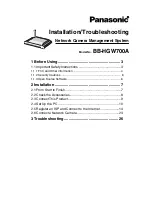
*Diaphragms require close precision tolerance, therefore only ADI diaphragms should be used as
replacements.
C. Disassembly of Head Section and Service Diaphragm
1. Remove head section by unscrewing the four large bolts. A flat-bladed screw driver may be
needed to gently pry the head free of the service diaphragm. **If you have Teflon coating on the
heads use caution not to scratch the surface.
2. The valve body can then be removed by unscrewing the two smaller screws (also accessible on
the top of the head section). This part may be freed by gently tapping on these two screws after they
have been loosened about three or four turns. When the valve body is removed, check all internal
surfaces for any accumulation of dirt. The two valve discs can be wiped clean and replaced as long
as they appear unaffected by usage. The valve gasket can be easily removed and should be
inspected. As a matter of good practice, the valve discs and valve gasket should be replaced during
any routine maintenance check of the head section. A once a year routine procedure is
recommended.
3. The service diaphragm is secured by the single screw in its center. Remove this screw with a
5/32" Allen wrench. The diaphragm and its clamping plate should be easily lifted off. Some slight
adherence to the metal may occur if the diaphragm has been in use for a long period.
4. When replacing the service diaphragm, a Teflon washer (part# 23001) should be inserted under
the head of the diaphragm cap screw. This is added insurance against small gas leaks through screw
heads and may be essential in vacuum applications where outside air contamination cannot be
tolerated. After tightening the screw, the excess Teflon should be trimmed away.
NOTE: When replacing the service diaphragm, be sure the four projecting studs of the base casting
are properly located in the four outer holes provided in the diaphragm before the part is clamped in
place. Be sure the diaphragm plate is firmly replaced with its center screw.
D. Disassembly and Replacement of the Connecting Rod
1. Remove head section and service diaphragm as described in (C) above. When this is done and the
front screen has been removed, the connecting rod assembly may be taken out (refer to exploded
view drawing). Gently pry up and remove the connecting rod cap (part# 3301) which is held in place
by the diaphragm screw.
2. Loosen but do not remove the counterweight screw. This is accessible from the top of the pump
base casting and will require a 5/32" hex allen wrench. The connecting rod eccentric assembly,
including counterweight and fan, will then slide of the motor shaft.
3. When replacing the eccentric assembly, be careful to align the flat section on the motor shaft with
the counterweight screw. The eccentric assembly should be aligned so the fan is on the outer side
from the motor. Slide this assembly as far onto the motor shaft as it will go before tightening the
counterweight screw onto the flat of the motor.
NOTE: After prolonged use, the eccentric assembly may freeze up on the motor shaft. A wheel
puller may be needed to free the part. When replacing the eccentric assembly, the motor shaft should
be lightly coated with a graphite or MDS based lubricant.
Summary of Contents for BALDWIN 225CE
Page 19: ...19 APPENDIX A MODEL 225...
Page 20: ......
Page 21: ......
Page 22: ...BALDWIN ENVIRONMENTAL INC...
Page 23: ...BALDWIN ENVIRONMENTAL INC...
Page 24: ......
Page 27: ...20 APPENDIX B SAMPLE CONDITIONING SYSTEM...
Page 28: ......
Page 29: ......
Page 30: ......
Page 31: ......
Page 32: ......
Page 33: ......
Page 34: ......
Page 38: ......
Page 39: ......









































